EQUIPMENT TEST REPORTS--Hirsch-Houck Laboratory test results on the: Kensonic
Accuphase T-100 AM/stereo FM tuner, Technics SA-5550 receiver, Leslie DVX speaker system, and Pioneer PL-15D41
turntable [Jan 1976] .
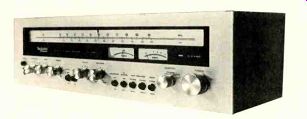
Technics SA-5550 Receiver
THE latest stereo receiver line from Technics by Panasonic, headed by their Mod el SA-5550, features a "new look" styling that follows the trend away from the "black out" dials that have been so widely used in re cent years. The satin-gold finish front panel still has a large rectangular dial cut-out, but the white dial face, with black markings, is clearly visible when the receiver is off. When it is on, the dial and the two tuning meters be low it are lit in white, providing excellent visibility and contrast. A thin black metal pointer and linear scale calibrations (on AM as well as FM) make it possible to select any frequency on the 8-inch dial with assurance. An orange light next to the meters indicates reception of a stereo transmission.
Below the dial area are the headphone jack and pushbutton power switch, followed by the SPEAKERS switch (controlling two pairs of speakers) and the bass and treble tone controls. These have eleven detented positions for positive resettability. Unlike any other receiver or amplifier we have seen, the SA-5550 does not use a separate tone-control amplifier stage, but places the controls in the feedback path around the direct-coupled complementary-symmetry power amplifier.
Two pushbuttons control the high and low filters; these are followed by the volume and balance controls. Next is a row of five push buttons, for the loudness compensation, FM interstation-noise muting, tape-monitor switching for two tape decks, and mono/ stereo mode selection. A knob with a choice of PHONO, FM AUTO, AM, and AUX selects the program source. A large tuning knob completes the front-panel control lineup.
In the rear of the receiver are the signal in put and output jacks, connectors for 300- and 75--ohm FM antennas and an AM wire antenna, a pivoted AM ferrite--rod antenna, and the speaker connectors. These (and the antenna terminals) are simple insulated binding posts.
The circuit--protective fuses, covered by a plastic shell, are accessible in the rear, and there are two a.c. outlets, one of them switched.
The amplifier section of the Technics SA-5550, which uses direct coupling to the speakers as well as between stages, is rated at 58 watts per channel into 8 ohms, or 72 watts into 4 ohms, from 20 to 20,000 Hz (both channels driven) at less than 0.3 percent total harmonic distortion (THD). The FM tuner section also carries impressive specifications, in Levels of random noise and total harmonic dist audio output level as input-signal strength including 1.8-microvolt (uV) usable sensitivity and distortion less than 0.2 percent in mono and 0.4 percent in stereo. A phase-locked loop integrated-circuit stereo demodulator is used.
The Technics SA-5550 is about 18 inches wide, 5 1/2 inches high, and 15 3/4 inches deep; it weighs approximately 28 pounds. Price: $479.95.
Laboratory Measurements. The amplifier output clipped at just under 74 watts per channel when both channels were driven into 8-ohm loads with a 1,000-Hz test signal. The 4-ohm power was 100 watts, and into 16 ohms it was 46.5 watts. At the rated 58 watts output, as well as the-3- and-10-dB output levels, the THD was 0.09 percent or less from 20 to 20,000 Hz. Typically, it was between 0.04 and 0.07 percent at most frequencies and power levels. The THD at 1,000 Hz, which was be low the noise level at outputs under 1 watt, was less than 0.05 percent up to 25 watts out put, increasing to 0.084 percent at 70 watts just before clipping. The intermodulation distortion (IM) was less than 0.2 percent from 60 watts down to about 12 milliwatts, and rose to 0.5 percent at 2 milliwatts output.
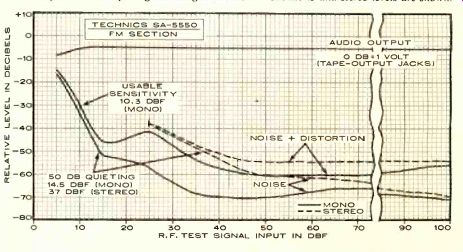
---------- Levels of random noise and total harmonic distortion
(which includes noise) are compared with audio output level as input-signal
strength increases. Both mono and stereo levels are shown.

----------- FREQUENCY IN Hz (CYCLES PER SECOND) kHz CONTINUOUS AND
EQUIVALENT SINE-WAVE WATTS/CHANNEL
The input sensitivity for a 10-watt output was 63 millivolts (mV) through the AUX in puts, and 0.75 mV through the phono inputs.
The hum and noise levels were very low: -75 and -73 dB, respectively. Phono overload occurred at a high 92-mV input--a good figure.
The RIAA equalization was accurate to with in ±1 dB from 30 to 15,000 Hz, and cartridge inductance had a negligible effect on the equalization (less than 2 dB up to 20,000 Hz).
The tone controls had the typical characteristics of feedback-type controls, with a sliding bass turnover frequency and a treble response hinged at about 1,000 Hz. At partial settings of the bass control it was possible to modify the response at frequencies under 100 Hz by 5 to 10 dB with absolutely no effect on frequencies above 200 Hz. The range of the bass tone control, in particular, was rather large, with a maximum boost of 20 dB at 40 Hz.
The high and low filters had gradual 6-dB-per-octave slopes, with the -3-dB response points at 120 and 4,000 Hz. The loudness compensation, whose action began at volume-control settings between -10 and -20 dB, boosted only the low frequencies.
The FM tuner section of the SA-5550 had a mono usable sensitivity of 10.3 dBf (1.8 uV), as rated. The stereo usable sensitivity was approximately the switching threshold of 20 dBf (5.5 uV). This signal level was also the muting threshold. The 50-dB quieting sensitivity was 14.5 dBf (2.9 uV) in mono with 0.6 percent distortion. In stereo, it was 37 dBf (39 µV) with 0.4 percent distortion. The mono noise-plus-distortion (N + D), after falling to 0.5 percent at 16 dBf (3.5 uV), rose to 0.85 percent at 25 dBf (10 uV). At higher signal levels the distortion dropped rapidly to a low 0.1 percent at 65 dBf (1,000 µV). In stereo, the distortion was 0.19 percent at 65 dBf, and the signal-to-noise ratio was 62 dB.
The FM frequency response was flat within ±0.4 dB from 30 to 15,000 Hz. Channel separation was very good, measuring better than 34 dB over the entire frequency range and about 40 dB from 100 to 5,000 Hz. The AM frequency response was notably good-down 6 dB at 60 and 8,500 Hz and varying only ±2 dB from 80 to 7,000 Hz.
In general, FM performance surpassed the published ratings in other characteristics also.
Capture ratio (rated 1.6 dB) was 1.25 dB at 65 dBf and a fine 3.6 dB at 45 dBf (100µV). (Cur rent IHF standards require that the rated value be the lower of these, but the specifications of the SA-5550 were drawn up before the issuance of the new standard.) The AM rejection of 67 dB was well in excess of the 50-dB rating, and the image rejection of 56.5 dB also exceeded the rated 50 dB. The alternate-channel selectivity, rated at 70 dB, measured 72.4 dB. Finally, even though the tuner frequency response showed no drop at 15,000 Hz, the 19-kHz pilot carrier leakage was reduced by an excellent 67.5 dB (rated 55 dB).
Comment. The Technics SA-5550 is, in every respect, a first-rate stereo receiver. Its electrical performance, in both the tuner and amplifier sections, not only meets or exceeds its ratings in all important respects, but is more than good enough to satisfy the requirements of even a critical hi-fi enthusiast. In addition, it is solidly built and well constructed, with no sloppiness or "rough spots" in its physical handling characteristics.
Some receivers, usually at considerably higher prices, may offer slightly more system flexibility (such as additional inputs, tape dubbing connections, etc.), but we doubt that many people will find the facilities of the SA-5500 to be inadequate. Its most obvious appeal would be to the person who has a pair (or two pairs) of low-efficiency speakers and needs substantial amounts of clean audio power to drive them. This conservatively rat ed receiver, when driving 4-ohm systems (or two 8-ohm systems) can deliver nearly 100 watts per channel at very low distortion.
We found the tuning-dial calibration to be unusually accurate, both on AM and FM bands. The linear AM scale is an unusual and useful feature, and it looks very different from the more common AM calibration, which is stretched at the low-frequency end of the band and is often so cramped at the up per end as to be nearly useless. On the SA-5550, the FM dial can be set with an ac curacy of considerably better than 100 kHz, and the AM tuning to better than 10 kHz, at any frequency within their respective ranges.
The AM tuner, as might be inferred from its frequency response, sounds considerably better than most. Not evident from the measurements, but equally important, is the almost total absence of noise between stations, as if a muting system were at work (although the receiver does not have one for AM). This is not the result of low sensitivity, since the SA-5550, using its built-in antenna, picked up an exceptionally large number of AM stations with complete freedom from buzzes, whistles, and other extraneous noises. The FM interstation-noise muting, incidentally, is excel lent, with a good "feel" to its operation and absolutely no transient sounds.
In a field of many fine receivers, the Technics SA-5550 definitely stands out as one of the more distinguished entries.
=========
Leslie DVX Speaker System
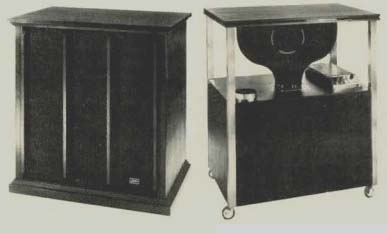
THE Leslie DVX loudspeaker, manufactured by a division of CBS, Inc., is a four way, five-driver system in a unique configuration intended to suit the special requirements of stereo and quadraphonic reproduction. The DVX has a conventional 15-inch woofer in a ported enclosure, crossing over at 250 Hz to a novel array of four drivers that radiate in a di pole (figure-eight) pattern. They are mounted on a specially shaped board, with an 8-inch cone handling frequencies from 250 to 1,000 Hz and a 3-inch cone operating from 1,000 to 5,000 Hz. The highest frequencies are reproduced by two small dome tweeters. The "di pole coupler" array radiates equally to the front and rear of the enclosure. Switches on the top of the woofer enclosure (behind the grille cloth) provide separate adjustment of levels in the lower mid-range, upper mid range, and high-frequency range. Each control has two 3-dB steps.
The Leslie DVX is designed so that the di pole pattern can be aimed anywhere in the listening area. The entire dipole panel is mount ed on a pivot and can be rotated through a ±60-degree angle in the horizontal plane. A calibrated scale indicates the angle between the pattern and the forward axis of the sys tem. By appropriate positioning of the dipole coupler axis, a correct stereo image can be heard from any listening position in a room.
Normally, as one moves closer to one speaker of a stereo pair, its direct radiation tends to dominate the weaker sound received from the other speaker, thus shifting the stereo image toward the listener. Because of the special directional properties of the Leslie DVX sys tem, however, moving toward one speaker tends to expose the listener to the strongest radiation from the more distant speaker while cutting down the level heard from the closer speaker. This makes one's perception of the stereo image nearly independent of listening position. The same advantage exists, to an even greater degree, in quadraphonic listening applications.
The rear radiation from the dipole coupler provides the diffuse, spacious effect often associated with reflecting or omnidirectional speakers while retaining the positive imaging of a front-radiating system. Although one might obtain somewhat similar results with conventional speakers by angling them in ward instead of facing them forward, this might lead to aesthetic problems. The DVX can be placed almost anywhere, facing in any convenient direction, and the dipole coupler can then be turned for optimum coverage of the listening area.
The Leslie DVX is available in a furniture styled version (the Model 570) that conceals the dipole coupler behind a grille cloth, and in an open "utility" or "studio" version (the Model 580, which we tested), in which the di pole coupler and level controls are exposed to view. The Model 570 is 30 inches wide, 33 1/4 inches high, and 20 1/2 inches deep; the Model 580 is about one inch shorter (optional casters are available for it at $16). Both systems weigh slightly over 100 pounds. Prices: Model 580, $473; Model 570, $449.
Laboratory Measurements. The frequency response of the Leslie DVX was measured with its level controls in their "0 dB" positions, corresponding to maximum high-frequency output and midway between maximum and minimum levels on the two mid range drivers. The bass response was measured with a closely spaced microphone, and a separate measurement of the port radiation was used to obtain a combined bass-output curve that was then joined to the dipole coupler response. The resulting frequency response was within ±5 dB from 40 to 16,000 Hz. Over most of that range it was about as flat as our semi-reverberant room measurement allows. There was a broad bass rise of about 5 dB centered at 70 Hz, and a rise of about 5 dB between 5,000 and 9,000 Hz. The output fell off smoothly above 12,000 Hz.
The woofer cone's direct radiation in a ported enclosure such as this falls off rapidly at low frequencies, where it is replaced by the port radiation (in the DVX, this occurs below about 35 Hz), and this makes woofer distortion measurements somewhat ambiguous. For example, the woofer output drops to near zero at about 28 Hz, which gives rise to an apparent increase in distortion at that frequency. Nevertheless, the distortion was quite low in the bass region, measuring less than 5 percent down to about 35 Hz at inputs up to 20 watts. The nominal system impedance is 4 ohms, and our impedance curve shows a resonant rise to 20 ohms at 45 Hz and an impedance generally above 4 ohms over the full audio range except for a drop to 3 ohms at 5,000 Hz.
The level switches make it possible to trim the response of the DVX to almost any de sired curve because of the separate control they provide in the 250-to-1,000, 1,000-to-5,000, and 5,000-to-20,000-Hz bands. We would judge that the DVX could be accommodated, both acoustically and visually, in almost any listening room large enough for two (or four) speakers of this considerable size.
The system is moderately efficient, producing a 91.5-dB sound pressure level at a distance of 1 meter with 1 watt of mid-range in put. It is protected by a 2-ampere fuse, but we did not blow the fuse even under very loud playing conditions-further attestation to the system's high overall efficiency over the musical frequency range.
The bass driver's tone-burst response was excellent: moderate ringing was seen following a 1,000-Hz burst and at some higher frequencies. It is, however, very difficult to realize an ideal tone-burst response from a multiple-driver system such as this in an acoustically "live" environment.
Comment. The results of our simulated live-vs.-recorded listening test closely confirmed the response measurements. There was a slight heaviness, audible on standard program material as well as our special recordings, which we attribute to the 70-Hz bass rise. The highs were very good, usually matching the original program so well that no difference could be heard. The chief difference was at the extreme high end (above 10,000 Hz), where sounds such as cymbals and wire brushes were slightly dulled. The dispersion of the sound was excellent at al frequencies.
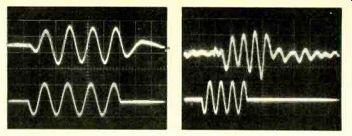
----- Tone-burst response of the DVX at 100 (left) and 1,000 Hz (right).
Input signals appear below.
We had previously heard a demonstration of the Leslie DVX in a quadraphonic array, and had been most impressed with the system's ability to maintain a good four-channel spatial perspective as one moved about the room. In our listening room, we found that it did just as well with stereo program material. Even when we stood directly in front of one speaker, the contribution of the other was heard undiminished.
In general, all speakers have their individual sound character, and the Leslie is no exception. We found it an easy speaker to listen to for extended periods, with no obvious coloration other than a tendency to warmth and richness in its sound. Despite its size, it is not sonically overwhelming in a small room, as are some other speakers of comparable bulk. In addition, we can confirm that the manufacturer's claims for its unique spatial qualities appear to be fully justified.
=================
Pioneer PL-15D- II Turntable
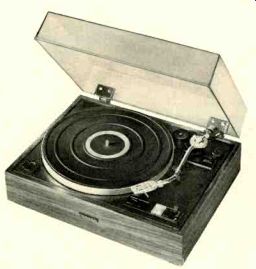
THE Pioneer PL-15D- II is a moderately priced two-speed (33 1/3 and 45 rpm) single-play turntable providing semi-automatic as well as fully manual operation. Its 12-inch, 2-pound platter of aluminum alloy is driven by a four-pole synchronous motor through a poly urethane belt. The speed-change lever on the motorboard shifts the belt on the stepped motor-shaft pulley.
The S-shaped tone arm, with a pivot-to-stylus distance of 8 11/16 inches, has a light weight perforated phono-cartridge shell that mounts with the widely used four-pin plug and locking-ring system. The counterweight rotates to balance the arm, and a scale on the weight is used to set the tracking force against a reference line on the arm tube. It is calibrated from 0 to 4 grams at 0.5-gram intervals. An anti-skating dial, with similar calibrations, is located on the motorboard near the arm base.
The motor starts automatically when the arm is lifted from its rest post. At the end of play, the arm lifts from the record and returns to its rest, shutting off the motor. It can also be returned manually at any time, or automatically by means of a CUT button on the motorboard (with a manual return, the motor remains on until the air button is pressed).
The cueing lever raises and lowers the pick up with a damped action in both directions. A stylus-position gauge is built into the motor-board in the form of a post that can be raised up to tone-arm level. When the stylus rests in a groove on its top, the overhang is set correctly. After the adjustment is made, the post is lowered out of the way again.
The Pioneer PL-15D-II is supplied on a walnut-finish wooden base with a hinged plastic dust cover. Approximate dimensions are: 17 inches wide, 14 inches deep, and 6 1/2 inches high. The 46-inch low-capacitance signal cables come with the unit. Price: $125.
Laboratory Measurements. The Pioneer PL-15D- II was tested with an Empire 2000E/ III cartridge installed in the tonearm. The tracking-force calibrations were very accurate, with an error of less than 0.05 gram at any setting. The tracking error was less than 0.7 degree per inch of record radius, reaching zero at a 2 1/2-inch radius (near the end of a record, where lowest possible tracking error is most desirable).
The anti-skating dial calibrations were also correct for providing equal tracking ability for the cartridge in both channels at very high recorded velocities. The cueing system worked smoothly (though care was needed to avoid jarring the entire turntable when lowering the pickup), and the outward drift caused by the anti-skating system was very slight (about one or two grooves). The low-frequency arm/cartridge resonance was at 7 Hz, with an amplitude of 7 to 8 dB. Although this resonance is determined by the particular cartridge used as well as by the arm (see this month's "Technical Talk " ), it should be typical of the behavior of this tone arm with most high-compliance cartridges. The cable capacitance was 75 picofarads, confirming the CD-4 suitability of the PL-15D-11.
The turntable speed was exact and did not change with line-voltage variations of 95 to 135 volts. The wow and flutter were respectively 0.03 percent and 0.05 percent (it is somewhat unusual for a turntable to have less wow than flutter) in an unweighted rms measurement. The total rms wow and flutter of 0.06 percent was well below Pioneer's specification of 0.08 percent (weighted rms). The rumble was -31 dB, including both lateral and vertical components, and -38 dB with the vertical rumble canceled. Applying RRLL audibility weighting produced a rumble figure of-51dB, also much better than Pioneer's specification of -48 dB.
The base of the PL-15D- II is not mounted on vibration-isolating feet, but the motor board and all its functional parts are spring mounted. Our tests showed that the sensitivity of the Pioneer unit to acoustic feedback was about average for low- to medium-price turntables and record changers, which rarely have sophisticated isolation features.
Comment. In all its operating characteristics, including the unspecified but important areas of set-up ease and operating convenience, the Pioneer PL-15D- II qualifies as a first-rate record player, the performance of which we could not fault. The rumble figure, through higher than we have measured on some higher-price turntables, is still better than we would normally expect to find in a unit at this price level.
In the price range of the PL-15D-11, there are a number of "automatic turntables" or record changers, only a few of which can match its overall quality. True, these machines can handle a stack of records automatically--something the PL-15D- II cannot do.
But on the other hand, the PL-15D-II confers special benefits in the area of speed stability and basic simplicity of construction which should translate into a potentially long and trouble-free life. Furthermore, there is still a useful amount of "automation" in its end-of play shut-off and arm return.

----- At left, a close-up of the PL-15D- II's pivot assembly shows
the adjustments for stylus force and anti-skating. At right, the gauge post
for setting correct stylus overhang is shown in use in its fully raised position.
The post retracts out of the way after the overhang setting has been made.
Also see:
CAN YOU REALLY HEAR THOSE HI-FI SPECS? It all boils down to dynamic range and achievable loudness.
Source: Stereo Review (USA magazine)